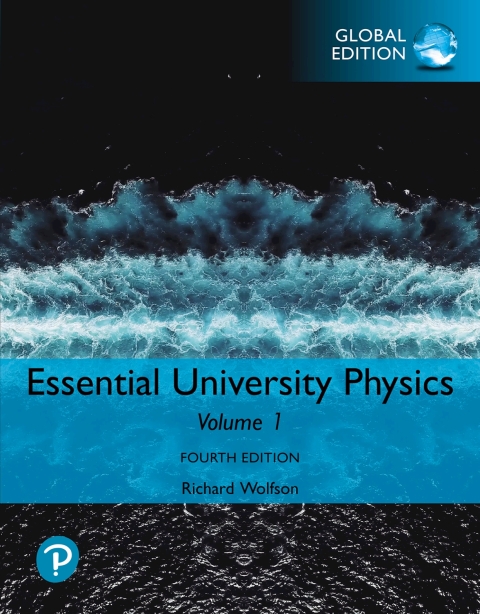Description
Efnisyfirlit
- Title Page
- Copyright Page
- Brief Contents
- Detailed Contents
- About the Author
- Preface to the Instructor
- Preface to the Student
- Video Tutor Demonstrations
- Chapter 1 Doing Physics
- 1.1 Realms of Physics
- 1.2 Measurements and Units
- 1.3 Working with Numbers
- 1.4 Strategies for Learning Physics
- Part One Mechanics
- 2 Motion in a Straight Line
- 2.1 Average Motion
- 2.2 Instantaneous Velocity
- 2.3 Acceleration
- 2.4 Constant Acceleration
- 2.5 The Acceleration of Gravity
- 2.6 When Acceleration Isn’t Constant
- 3 Motion in Two and Three Dimensions
- 3.1 Vectors
- 3.2 Velocity and Acceleration Vectors
- 3.3 Relative Motion
- 3.4 Constant Acceleration
- 3.5 Projectile Motion
- 3.6 Uniform Circular Motion
- 4 Force and Motion
- 4.1 The Wrong Question
- 4.2 Newton’s First and Second Laws
- 4.3 Forces
- 4.4 the Force of Gravity
- 4.5 Using Newton’s Second Law
- 4.6 Newton’s Third Law
- 5 Using Newton’s Laws
- 5.1 Using Newton’s Second Law
- 5.2 Multiple Objects
- 5.3 Circular Motion
- 5.4 Friction
- 5.5 Drag Forces
- 6 Energy, Work, and Power
- 6.1 Energy
- 6.2 Work
- 6.3 Forces That Vary
- 6.4 Kinetic Energy
- 6.5 Power
- 7 Conservation of Energy
- 7.1 Conservative and Nonconservative Forces
- 7.2 Potential Energy
- 7.3 Conservation of Mechanical Energy
- 7.4 Nonconservative Forces
- 7.5 Conservation of Energy
- 7.6 Potential-Energy Curves
- 8 Gravity
- 8.1 Toward a Law of Gravity
- 8.2 Universal Gravitation
- 8.3 Orbital Motion
- 8.4 Gravitational Energy
- 8.5 The Gravitational Field
- 9 Systems of Particles
- 9.1 Center of Mass
- 9.2 Momentum
- 9.3 Kinetic Energy of a System
- 9.4 Collisions
- 9.5 Totally Inelastic Collisions
- 9.6 Elastic Collisions
- 10 Rotational Motion
- 10.1 Angular Velocity and Acceleration
- 10.2 Torque
- 10.3 Rotational Inertia and the Analog of Newton’s Law
- 10.4 Rotational Energy
- 10.5 Rolling Motion
- 11 Rotational Vectors and Angular Momentum
- 11.1 Angular Velocity and Acceleration Vectors
- 11.2 Torque and the Vector Cross Product
- 11.3 Angular Momentum
- 11.4 Conservation of Angular Momentum
- 11.5 Gyroscopes and Precession
- 12 Static Equilibrium
- 12.1 Conditions for Equilibrium
- 12.2 Center of Gravity
- 12.3 Examples of Static Equilibrium
- 12.4 Stability
- Part Two Oscillations, Waves, and Fluids
- 13 Oscillatory Motion
- 13.1 Describing Oscillatory Motion
- 13.2 Simple Harmonic Motion
- 13.3 Applications of Simple Harmonic Motion
- 13.4 Circular Motion and Harmonic Motion
- 13.5 Energy in Simple Harmonic Motion
- 13.6 Damped Harmonic Motion
- 13.7 Driven Oscillations and Resonance
- 14 Wave Motion
- 14.1 Waves and Their Properties
- 14.2 Wave Math
- 14.3 Waves on a String
- 14.4 Wave Energy
- 14.5 Sound Waves
- 14.6 Interference
- 14.7 Reflection and Refraction
- 14.8 Standing Waves
- 14.9 the Doppler Effect and Shock Waves
- 15 Fluid Motion
- 15.1 Density and Pressure
- 15.2 Hydrostatic Equilibrium
- 15.3 Archimedes’ Principle and Buoyancy
- 15.4 Fluid Dynamics
- 15.5 Applications of Fluid Dynamics
- 15.6 Viscosity and Turbulence
- Part Three Thermodynamics
- 16 Temperature and Heat
- 16.1 Heat, Temperature, and Thermodynamic Equilibrium
- 16.2 Heat Capacity and Specific Heat
- 16.3 Heat Transfer
- 16.4 Thermal-Energy Balance
- 17 The Thermal Behavior of Matter
- 17.1 Gases
- 17.2 Phase Changes
- 17.3 Thermal Expansion
- 18 Heat, Work, and the First Law of Thermodynamics
- 18.1 The First Law of Thermodynamics
- 18.2 Thermodynamic Processes
- 18.3 Specific Heats of an Ideal Gas
- 19 The Second Law of Thermodynamics
- 19.1 Reversibility and Irreversibility
- 19.2 The Second Law of Thermodynamics
- 19.3 Applications of the Second Law
- 19.4 Entropy and Energy Quality
- Appendices
- Appendix A Mathematics
- Appendix B The International System of Units (SI)
- Appendix C Conversion Factors
- Appendix D The Elements
- Appendix E Astrophysical Data
- Answers to Odd-Numbered Problems
- Answers to Odd-Numbered Problems
- Credits
- Index






Reviews
There are no reviews yet.